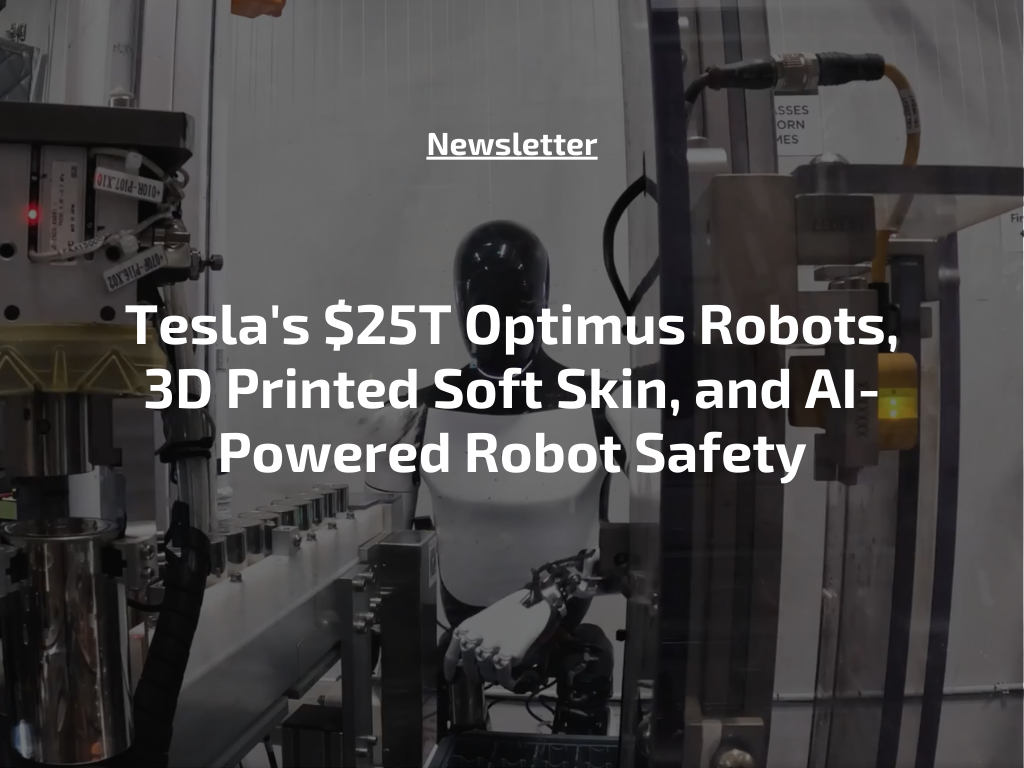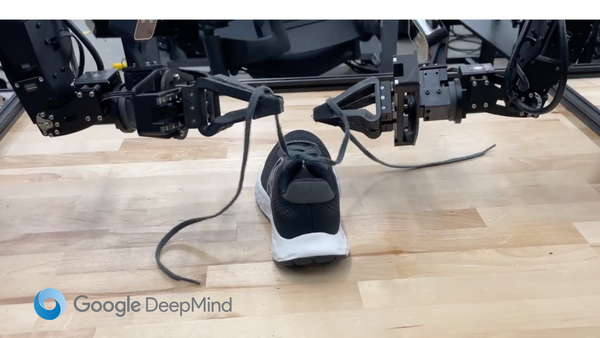Tesla's $25T Optimus Robots, 3D Printed Soft Skin, and AI-Powered Robot Safety
Explore major advancements in the humanoid robot market, including Tesla's $25T Optimus projections, 3D printed robotic skin, touch-sensitive technology, and AI-powered robot safety innovations.

The humanoid robot market is experiencing rapid advancements, capturing attention across multiple industries.
Musk believes Tesla's ambitious plans for its Optimus robots could potentially catapult the company to a $25 trillion market cap. Meanwhile, researchers are making strides in 3D printing soft skin pads for robots, enhancing their safety and interaction capabilities.
Additionally, innovations are enabling both robots and amputees to feel touch with human-like precision. Boston Dynamics is also leading the way in AI-powered robot safety, emphasizing ethical use and robust governance.
These developments highlight the potential of humanoid robotics in industrial, healthcare, and everyday applications.
Let's dive in...
Elon Musk Says Tesla's Optimus Robots Could Boost Market Cap to $25 Trillion
Elon Musk's bold claims at Tesla's 2024 annual shareholder meeting suggest that the company's humanoid robot, Optimus, could propel Tesla to a market cap of $25 trillion.
This announcement, coupled with Tesla's recent deployment of two autonomous Optimus robots in a factory, highlights significant advancements and ambitious projections for the company's future in robotics.
WHAT YOU NEED TO KNOW
- Massive Market Cap Projection: Elon Musk believes that the Optimus robots could help Tesla achieve a market cap of $25 trillion, which is more than half the current value of the S&P 500, surpassing top companies like Apple and Microsoft.
- Autonomous Factory Robots: Tesla has deployed two Optimus robots working autonomously in a factory, marking a significant milestone in their robotics initiative and showcasing the potential for fully autonomous humanoid robots in industrial applications. (Tweet below)
- Future Capabilities and Affordability: Musk announced plans for limited production of Optimus robots by 2025, with thousands expected to be operational in Tesla factories. He suggested that the robots could perform various tasks and be available for sale as early as next year for less than $25,000, making them affordable for a wide range of applications.
Rundown of what we have achieved since 2018 – under @elonmusk's leadership
— Tesla (@Tesla) June 11, 2024
–
2018
– Hit 5k Model 3/week
– Model 3 becomes best-selling EV in the US
– Giga Nevada reached annual battery production rate of 20 GWh
– Launched Navigate on Autopilot
– Model 3 becomes the best-selling…
WHY YOU SHOULD CARE Understanding the development and potential impact of Tesla's Optimus robots is crucial for several reasons:
- Transformative Potential: Optimus robots could address labor shortages, enhance productivity, and perform diverse functions, from household chores to factory work, revolutionizing tasks.
- Economic Implications: Musk's projection of a $25 trillion market cap reveals the enormous economic potential he sees in robotics and AI, which could significantly influence market trends and investment strategies, while the affordability of Optimus robots could democratize access to advanced robotics across various industries.
- Technological Leadership: Tesla's focus on advancing robotics technology places it at the forefront of innovation. Success in this venture could solidify Tesla's position as a leader in the automotive and robotics industries, impacting competitors and shaping the future of technological advancements.
3D Printers Improving Robotic Skin and Decreasing Costs
Researchers at the University of Illinois Urbana-Champaign have developed a method for efficiently manufacturing soft skin pads with integrated touch sensors using 3D printers.
This innovation addresses previous challenges related to cost and practicality, offering a new solution for creating safer, more intuitive robots capable of interacting with humans.
WHAT YOU NEED TO KNOW
- 3D Printing Innovation: The study demonstrated that thermoplastic urethane can create soft skin pads that function as flexible coverings and pressure-based mechanical sensors, making the manufacturing process efficient and cost-effective.
- Enhanced Safety and Functionality: The 3D-printed pads ensure mechanical safety compliance and tactile sensing, halting a robot's movement upon detecting hazardous proximity and allowing robots to interpret physical interactions as instructions.
- Cost-Effectiveness and Customization: This technique significantly reduces the cost and complexity of tactile robotic sensors. Reprogramming 3D printers allows for easy customization, making them suitable for various robotic systems and practical applications, such as in healthcare settings where frequent sanitization or part replacement is necessary.
WHY YOU SHOULD CARE
Understanding the advancement in 3D-printed soft skin pads for robots is crucial for several reasons:
- Revolutionizing Human-Robot Interaction: This development enhances robots' safety and intuitiveness, making them more suitable for direct human interaction and various industrial and domestic applications.
- Cost and Efficiency: The cost-effective manufacturing process and ease of customization open new opportunities for deploying robotic systems in environments where traditional methods were previously impractical due to high costs or maintenance issues.
- Expanding Robotic Capabilities: Integrating tactile sensing through these soft skin pads adds a new dimension to robotic control and interaction, providing critical force-level data that enhances a robot’s ability to interact with its environment. This innovation could lead to broader adoption and new use cases for robots across multiple industries.
Source: Tech Explorist
Tech Helps Robots And Amputees To Feel Touch
Researchers at Uppsala University and Karolinska Institutet have developed an advanced artificial tactile system that enables humanoid robots and prosthetic hands to sense touch with the same responsiveness as humans.
This innovative technology mimics the human nervous system using electrical pulses, potentially transforming how robots interact with their environment and enhancing prosthetic functionality.
WHAT YOU NEED TO KNOW
- Human-Like Touch Sensation: The artificial tactile system developed by the researchers uses electronic skin (e-skin) and artificial neurons to mimic human touch, allowing robots and prosthetics to recognize objects and surfaces with high accuracy.
- Advanced Capabilities: This system can distinguish between different materials, detect pain and heat, and has successfully identified 22 objects and 16 types of surfaces during tests, showcasing its advanced sensory capabilities.
- Broad Applications: Beyond enhancing robot-human interactions and prosthetic dexterity, this technology has potential medical applications, including monitoring movement dysfunctions in diseases like Parkinson’s and Alzheimer’s and aiding stroke patients in regaining functionality.
WHY YOU SHOULD CARE
Understanding the development of this artificial tactile system is crucial for several reasons specific to humanoid robots:
- Enhanced Interaction: For humanoid robots, the ability to sense touch like a human means more natural and safe interactions, significantly improving their utility in industrial to domestic settings. This could lead to robots that can handle delicate tasks and interact more seamlessly with human co-workers.
- Improved Utility: With the ability to recognize different materials and detect pain and heat, humanoid robots equipped with this tactile system can perform more complex tasks in diverse environments, from handling fragile items in warehouses to providing care in healthcare settings.
- Advancement in Human-Robot Collaboration: This tactile technology enhances the potential for humanoid robots to work alongside humans, reducing the risk of accidents and improving efficiency in tasks that require a delicate touch or precise handling. This could revolutionize industries like manufacturing, logistics, and personal assistance, making humanoid robots more practical and versatile.
Source: TechRound
Boston Dynamics Shows Off AI-Powered Robot Safety Improvements
At the AI Summit London, Boston Dynamics highlighted its efforts to enhance robot safety through AI-powered self-learning technologies.
Brendan Schulman, the company's vice president of policy and government relations, discussed the ethical use of robotics, recent advancements, and the importance of governance in ensuring the safe deployment of robots in various applications.
WHAT YOU NEED TO KNOW
- AI-Driven Safety Enhancements: Boston Dynamics is using AI-powered self-learning to improve the safety and reliability of its robots. For instance, reinforcement learning enabled the Spot robot to navigate wet floors, a capability rolled out to all Spot units via a software update.
- Ethical and Policy Frameworks: The company is actively involved in governance and legislative efforts to prevent the weaponization of robots. Schulman emphasized the need for international collaboration to create robust AI governance models.
- Industrial and Health Applications: Boston Dynamics robots are used in public safety and industrial applications. The Stretch robot, designed for warehouse automation, aims to alleviate physically demanding tasks, reflecting the broader trend towards automation in response to an aging workforce.

WHY YOU SHOULD CARE
Understanding Boston Dynamics’ approach to AI-powered robot safety is crucial for several reasons:
- Technological Innovation and Safety: The integration of AI for self-learning capabilities in robots like Spot demonstrates how technology can enhance operational safety and efficiency. This is vital for industries relying on robotics for complex tasks.
- Ethical Considerations: The company's commitment to ethical robotics and its involvement in legislative efforts highlight the importance of responsible AI development. This ensures that advancements in robotics do not pose unforeseen risks to society.
- Future Workforce Implications: With robots taking on more physically demanding jobs, there is a growing need for workforce training and education. Understanding these trends is essential for preparing the future workforce to manage and coexist with advanced robotic systems, ensuring safer and more productive work environments.
Source: IoT World Today



